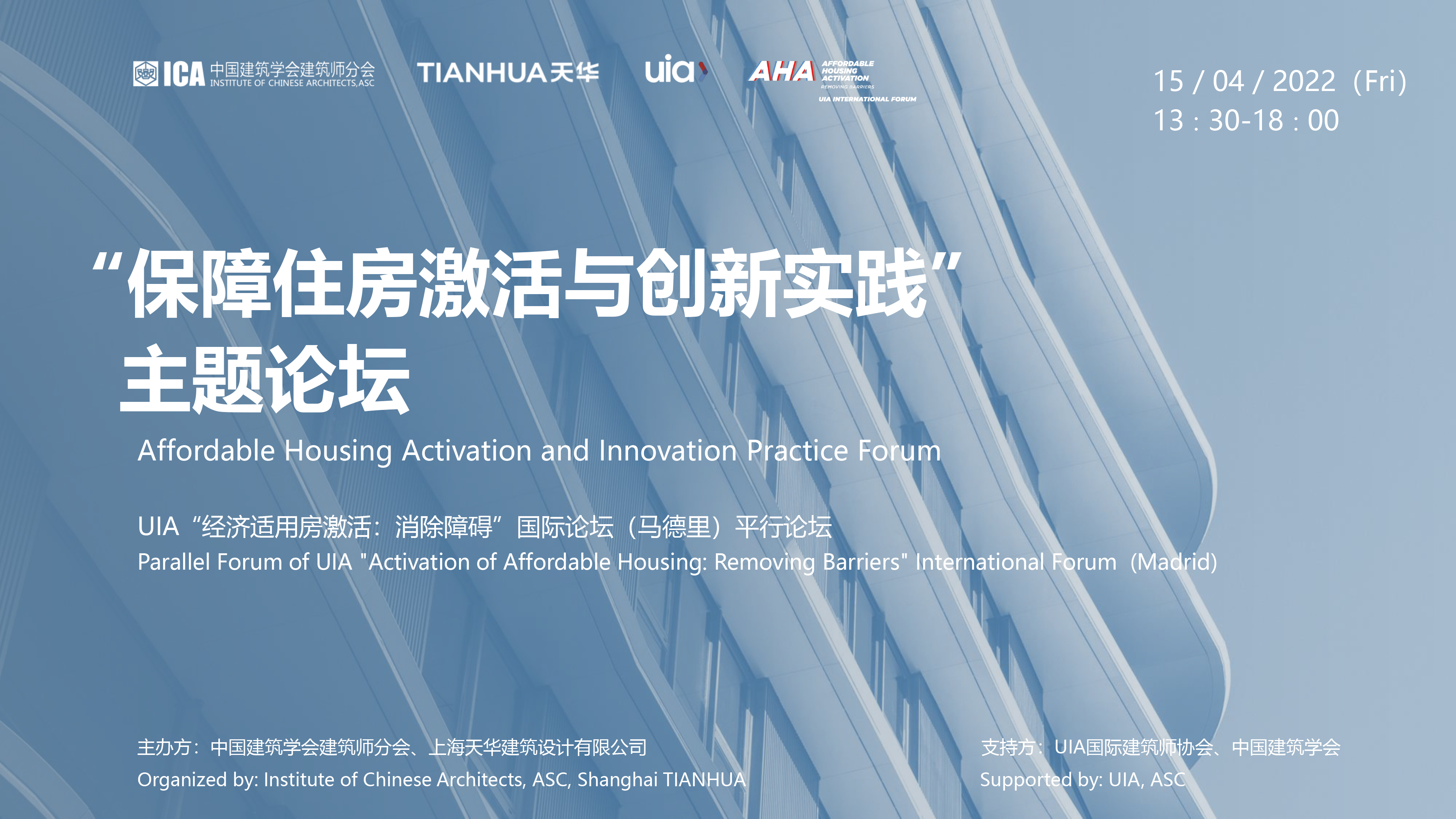30
Apr
2022
[Video Playback] Whole Process Record of Affordable Housing Activation and Innovation Practice Forum
Wonderful Review of Expert Speeches
On April 15, 2022, the Affordable Housing Activation and Innovation Practice Forum, a parallel event of UIA "Activation of Affordable Housing: Removing Barriers" International Forum, was successfully held via the live-streaming of Tencent Meeting.
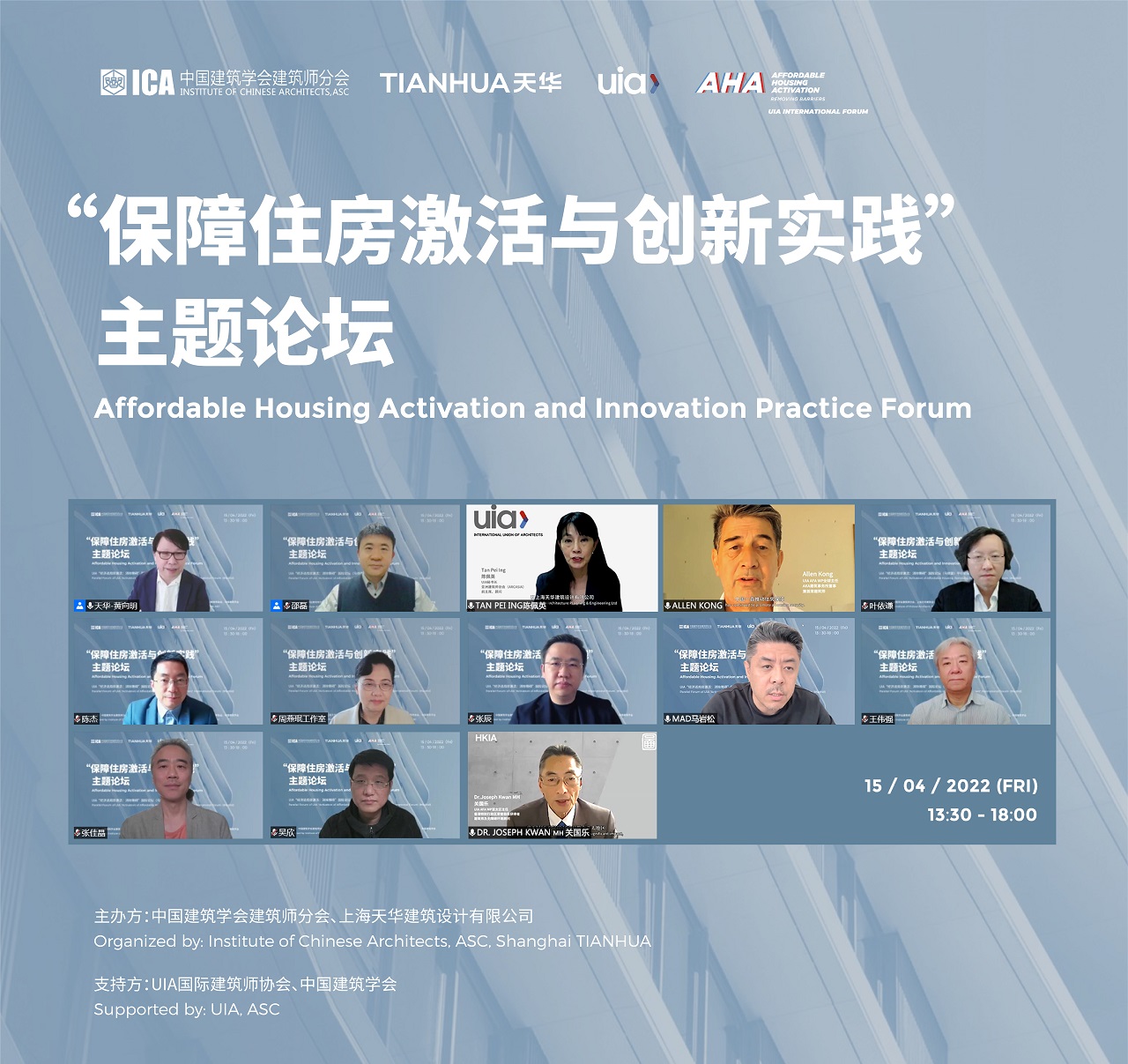
The forum was jointly organized by the Institute of Chinese Architects, ASC and Shanghai TIANHUA Architecture Planning & Engineering Ltd., with the support of UIA and ASC. The conference was jointly presided over by Huang Xiangming, director and chief architect of TIANHUA Group, member of UIA Architecture For All Work Programme and director of Institute of Chinese Architects, ASC, as well as Shao Lei, director of the Residence and Community Research Institute of School of Architecture, Tsinghua University and member of UIA Architecture For All Work Programme.
▲Full Video Playback of the Forum
Opening Session
After the beginning of the forum, host Huang Xiangming introduced the organizers, supporters, guests and main agenda of this forum in turn and explained that the forum was a parallel forum of UIA "Activation of Affordable Housing: Removing Barriers" International Forum in Madrid (to be held on May 18-20, 2022 in Madrid). Under the guidance of the development vision of the 14th Five-Year Plan, the forum might discuss and show China's thinking and practical achievements in the field of social affordable housing in the form of keynote speeches and round-table discussions, where experts from various fields participated in by combining the development background of the continuous improvement of China's housing support system in recent years.
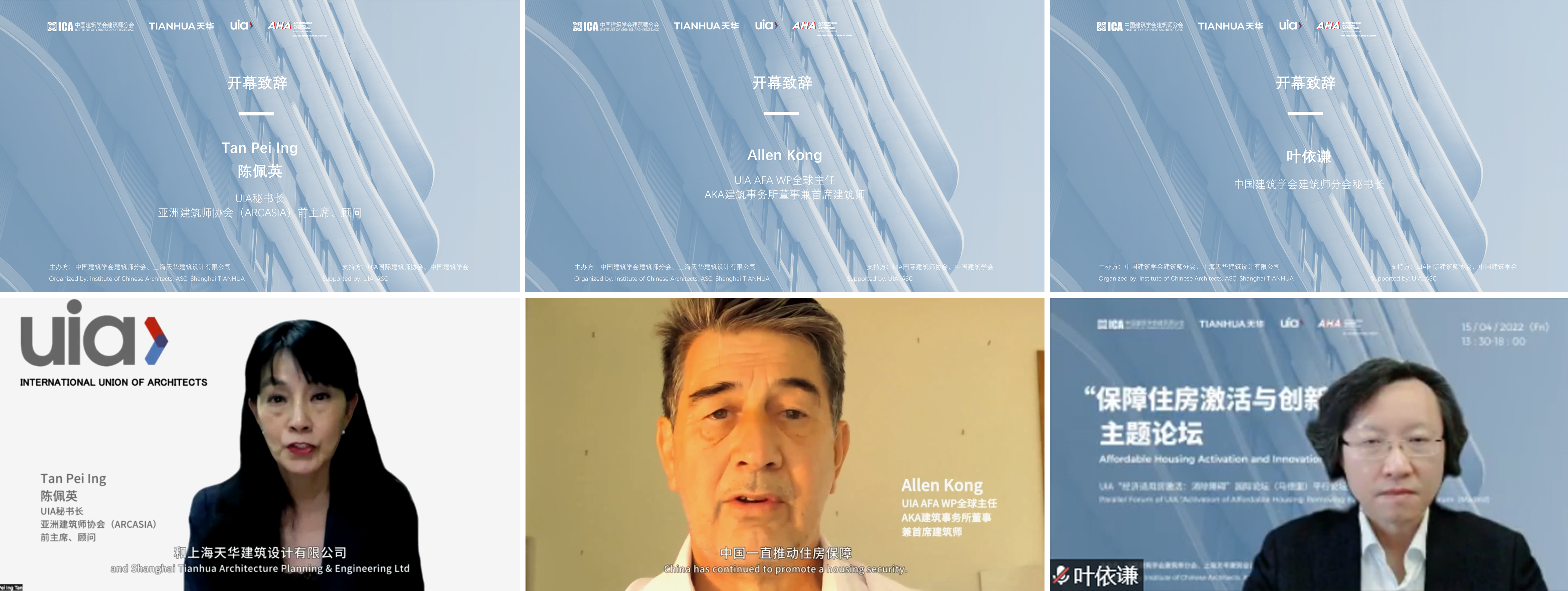
▲Guest Speakers of Opening Session
Tan Pei Ing, secretary-general of UIA, former president and advisor of Architects Regional Council Asia (ARCASIA) delivered the opening speech. She expressed her sincere gratitude to the organizers and supporters of the forum and explained that the major objective of the UIA Madrid International Forum was to bring together the knowledge and experience of housing issues worldwide and to work out innovative and practical solutions to the supply of safe and affordable housing for all people through the establishment of a collaborative framework. In particular, she pointed out that safe and affordable housing was a fundamental right of everyone and was part of the United Nations Sustainable Development Goals 11.1: make cities and human settlements inclusive, safe, resilient and sustainable", as well as the highest vision that must be strived for without leaving anyone behind. UIA has designated 2022 as the "Year of Healthy Design" and advocated the incorporation of healthy and sustainable design principles into all types of design and development planning including affordable housing to promote the relationship between man and nature with sustainable transportation and green public spaces.
Finally, she stressed that design was an important tool for integrating health into the architectural environment and policies and that architects would play a crucial role in the planning for sustainable development. She called on all experts and architectural practitioners to work together to make meaningful changes in the design and construction of healthy communities that are beneficial to the overall health and well-being of humanity.
Allen Kong, global director of UIA Architecture For All Work Programme delivered the second online opening speech in Melbourne, Australia. Firstly, he paid tribute to the culture of Australia's indigenous residents and the past, present and future. He also reiterated the objective of UIA Architecture For All Work Programme – to encourage and promote equal access to the architectural environment; to remove barriers to segregation and construct buildings and venues that are friendly, equally accessible, understandable and sustainable for all; to share good practices and innovative knowledge in terms of accessibility and inclusion; to strive to achieve the United Nations Sustainable Development Goals 11.1, and to create inclusive, safe, resilient and sustainable cities and human settlements.
Finally, Allen Kong expressed his gratitude to the Institute of Chinese Architects, ASC and Shanghai TIANHUA Architecture Planning & Engineering Ltd., the co-organizers of this forum. He emphasized that China has been promoting housing security, and presented thoughts and achievements in the fields of affordable housing system construction, design innovation and technology research and development through this forum, expressing the expectations of people from all walks of life for this forum.
Ye Yiqian, secretary general of Institute of Chinese Architects, ASC, delivered the third opening speech. First, he introduced that UIA is an important international organization for the exchange of architects all over the world. As a national member of UIA, the Institute of Chinese Architects, ASC integrated relevant resources and jointly organized this parallel event of UIA International Madrid Forum with TIANHUA, aiming at discussing the thoughts and achievements in the field of affordable housing with the world.
Since its establishment more than 60 years ago, ASC has continuously publicized and implemented the guidelines and requirements of the Party and the State, and has set up a platform for domestic and international communication. It has always been at the forefront of the development of architectural science and technology, reflecting its unique academic value and spiritual realm. Institute of Chinese Architects, a branch directly under the ASC, adheres to the purpose of "developing academic activities, prospering architectural creation and giving full play to the social role of architects", thereby continuously promoting the development and progress of the industry.
He particularly emphasized that housing is a social problem that underpins people's livelihood and involves fairness and justice. In order to help realize the long-term goal of the "14th Five-Year Plan", China has continuously promoted the housing security system featuring public rental housing, affordable rental housing and housing with common property rights in recent years, and has established a relatively sound housing security policy and management system.
Finally, Ye Yiqian said that this "Affordable Housing Activation and Innovation Practice Forum" closely follows the theme of UIA Madrid International Forum, and would jointly explore sustainable solutions to future urban problems with the world, which could become another successful exploration of ASC to strengthen international exchanges and cooperation.
Keynote Speech (I): Development Planning and Layout for Affordable Housing
The keynote speech in the first part of the forum was hosted by Shao Lei, and three guests with different backgrounds, such as academic circles, development and operation, delivered speeches respectively.
Professor Chen Jie, from Center for Housing and Urban-Rural Development of Shanghai Jiao Tong University, delivered a speech entitled Affordable Housing 3.0: Prospects and Strategies.
Chen Jie said that the theme of affordable housing is related to housing rights, while housing is closely related to communities, employment opportunities and security. He introduced three modes of public housing in the world, and pointed out that the construction of China's housing security system was explored earlier. Since 1991, the State Council has put forward relevant measures such as "vigorously developing economical and practical commercial housing" and "tiered housing supply system". In 1998, the symbolic housing reform document proposed to establish and improve the housing supply system based on affordable housing, and the version 1.0 of China's affordable housing officially appeared. At the same time, the housing fund system emerged and gradually matured, and the financial means of housing security were also developed. In 2007, the State Council proposed to speed up the establishment and improvement of a policy system focusing on the low-rent housing system and solving the housing difficulties of urban low-income families through multiple channels, and the version 2.0 of China's affordable housing officially appeared. System 2.0 is more effective than system 1.0, but there are still some problems, such as the lack of incentive mechanism for participation of local government and social forces, and the ineffective sustainable development and recycling mechanism of housing security assets. At the national level, "policy-based rental housing" was considered for experimental exploration, and later officially named as "affordable rental housing". It is mentioned in the 14th Five-Year Plan (2021-2025) and the Outline of the Long-Range Objectives for 2035 that focus should be placed on cities with large population inflow and high housing prices, and the supply of affordable rental housing should be expanded, in a bid to solve the housing problems of disadvantaged groups and new citizens. In 2021, the Ministry of Housing and Urban-Rural Development proposed that the development of affordable rental housing was a major decision-making arrangement made by the CPC Central Committee and the State Council, and version 3.0 of China's affordable housing was formally formed.
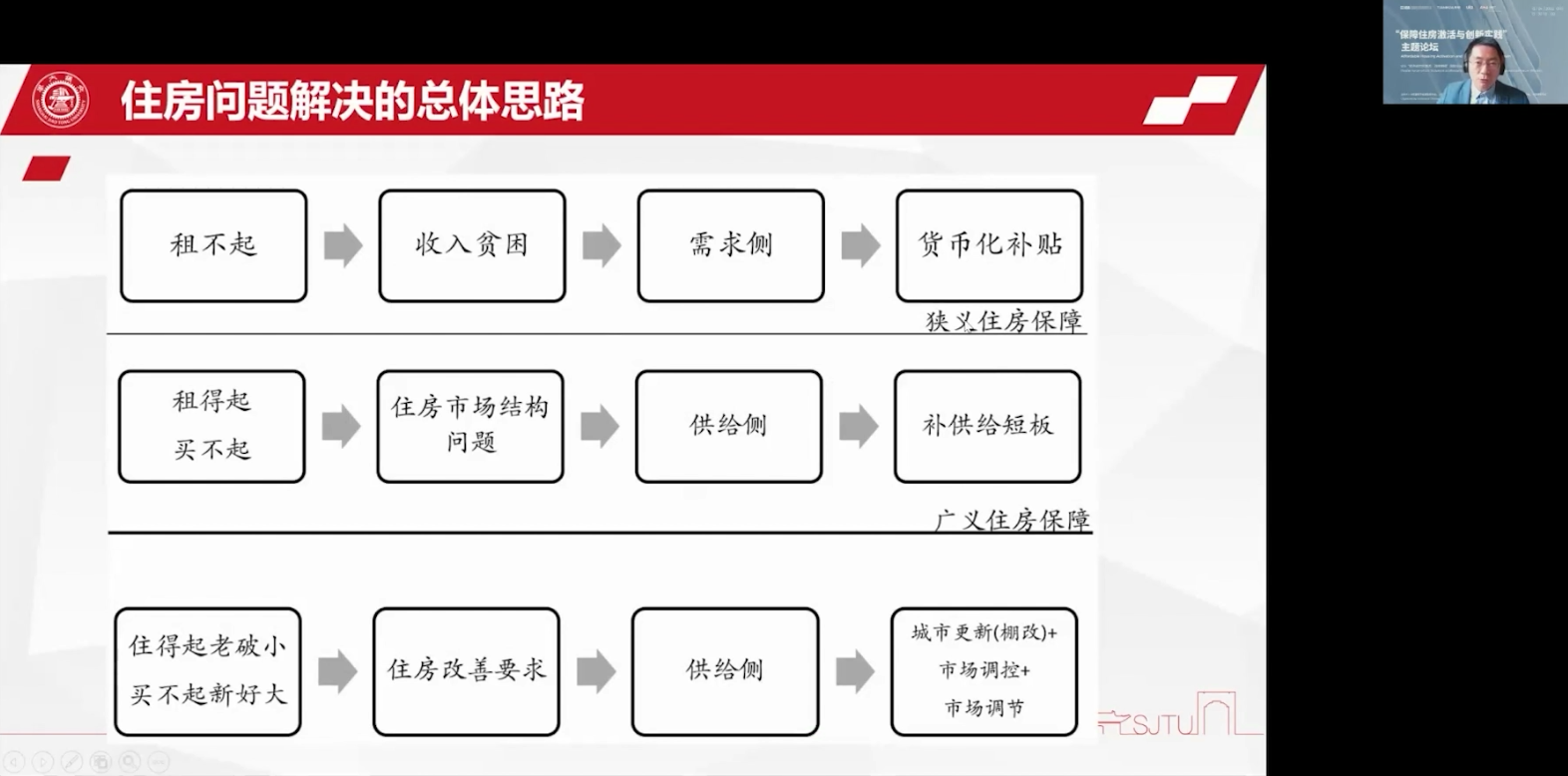
China's affordable housing 3.0 is supported by the government, which mainly uses group constructive land, idle land owned by enterprises and public institutions, supporting land in industrial parks and idle houses in stock to support specialized large-scale housing leasing enterprises to build, operate and manage affordable rental housing. China's affordable housing 3.0 has the advantages of clearer objects, finer contents, more precise forces, more operable schemes, more market-oriented methods, maximized social benefits, and scientific handling of the relationship between stock and increment, which represents going beyond the backstop housing security to the development-oriented housing security. In order to alleviate the difficulties in raising land, housing and financing for affordable rental housing, the National Development and Reform Commission has formulated supportive policies such as promoting Real Estate Investment Trusts (REITs), and architects and industry associations have continuously explored the possibility of asset intervention from the beginning of construction and design.
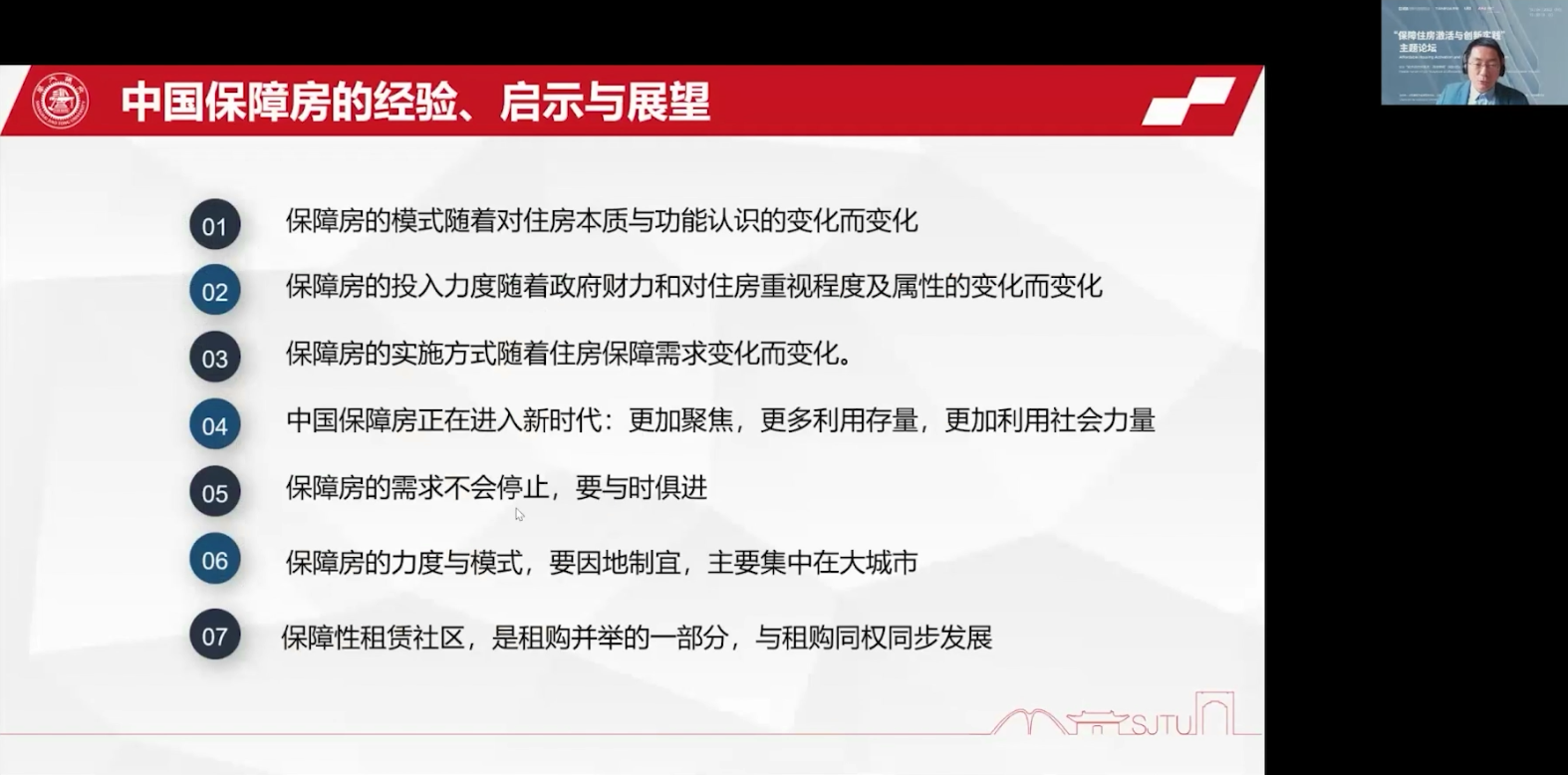
Chen Jie concluded that China's affordable housing system is developing constantly, the model of affordable housing changes with the understanding of the nature and function of housing, and the investment in affordable housing varies with the government's financial resources, attention and attributes. China's affordable housing is entering a new era of more focus, more use of stock, more use of social forces, better adaptation to local conditions and keeping pace with the times.
Professor Zhou Yanmin, from School of Architecture, Tsinghua University, delivered a speech entitled User Demand and Space Design Strategies of Affordable Housing. Professor Zhou Yanmin and her team understand the needs and existing problems of residents through field research on Beijing public rental housing projects, and learn from foreign experience to think about the improvement of space design.
According to the report, through the field investigation in Beijing, they found that because the age, physical condition and other conditions of the recipients are unclear, the elderly without fixed income have become the actual users of public rental housing. Due to the old people's habit of hoarding old things and lack of indoor storage space, the occupation of public space in the corridor of public rental housing is prominent, resulting in a series of problems such as insufficient space for safe evacuation and management. In addition, the external public space of public rental housing is often occupied as a place for business, planting and other activities. On the other hand, the elderly pay more attention to communicating with their families and their neighbors, which plays a good role in maintaining the social contact safety in public space.
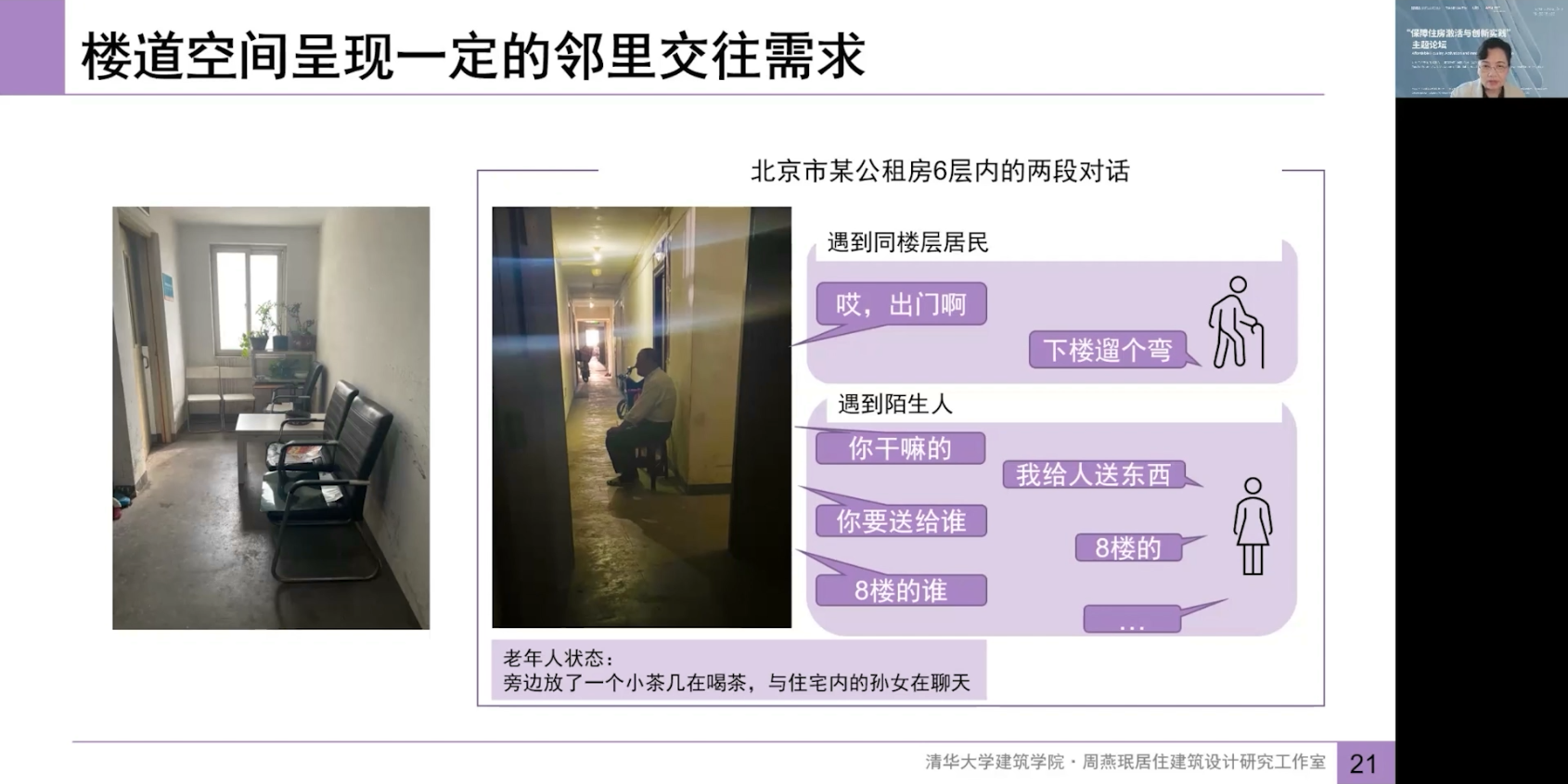
According to the research results of Japan, Singapore and other countries, Zhou Yanmin demonstrated the practice of reserving or designing storage space for public rental housing through practical cases, promoting the communication among residents and solving the problems of storage at the door, aging treatment, and the design highlights of entrance buffer zone, public flower pool, tube well, outdoor activity venue and other areas, which could provide valuable reference for the design improvement of affordable housing in China.
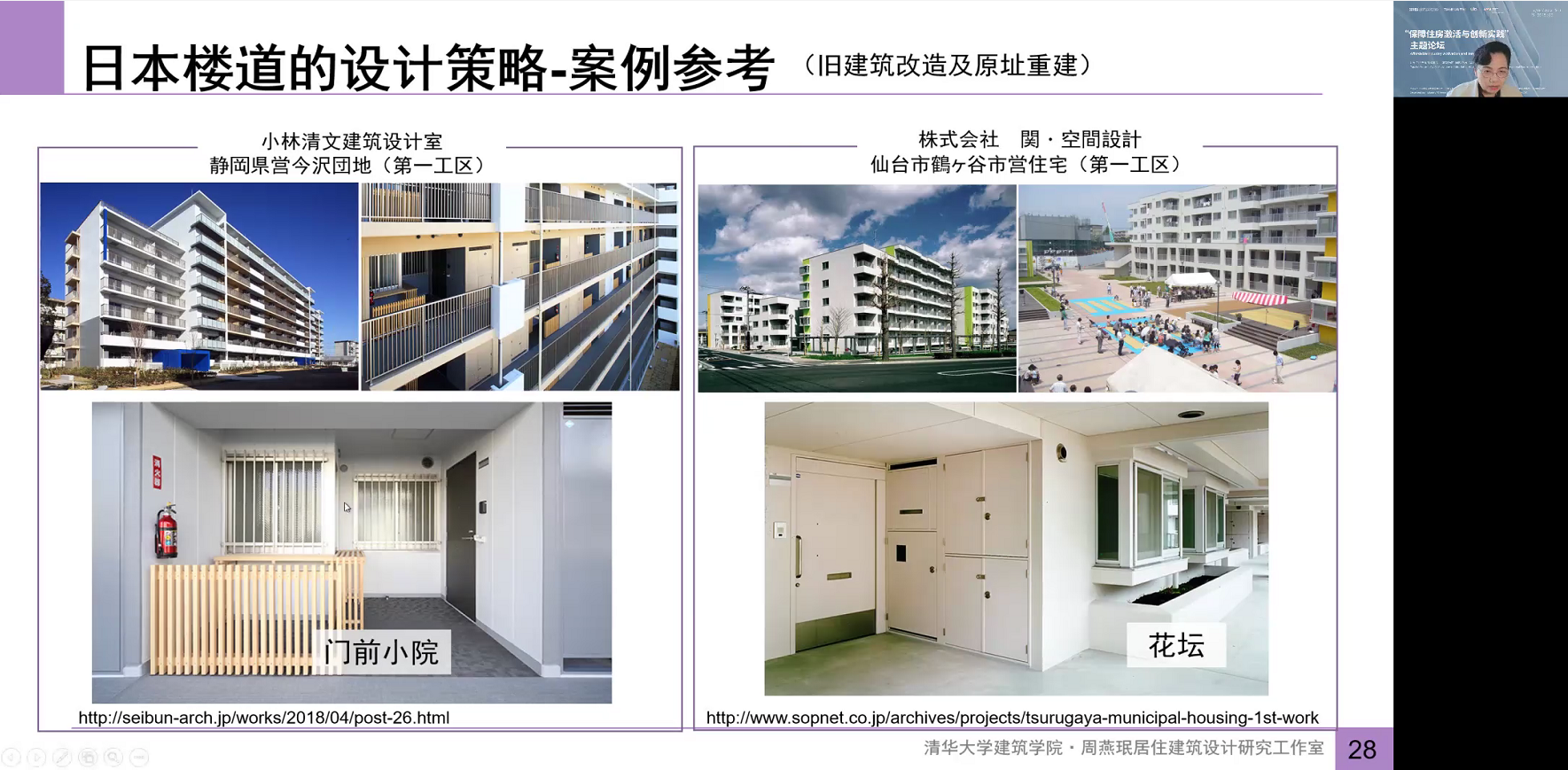
Zhou Yanmin concluded that for the design of public rental housing, we should consider the actual users and their demand changes, and pay attention to increasing the storage space; use the channel space to increase the communication between people, so that people can strengthen communication and reduce loneliness; public house is considered to be set up in the ground floor and other spaces to facilitate the service for the elderly, so that public rental housing and affordable housing can operate better and continuously.
Zhang Chen, president of Shanghai Chengtou Holding Co., Ltd., delivered speech entitled Development and Operation of Affordable Housing. With a developer background, Zhang Chen shared the practical achievements of Shanghai and Shanghai Chengtou in the field of affordable housing and rental housing for many years from the perspective of investors, builders and operators. He said that since 2002, Shanghai Chengtou has undertaken about 15% of the construction tasks of affordable housing in Shanghai, and solved the problem of improving the housing of nearly 200,000 people. With the continuous evolution of Shanghai's affordable housing policy, the affordable housing developed by Shanghai Chengtou have gone through four stages, which are closely related to the four stages of Shanghai's affordable housing policy development. Zhang Chen pointed out that the main purpose of building affordable rental housing at present is to solve the basic housing problem of new citizens and young people in first-tier cities, so as to retain young talents through the allocation of rental housing, and ensure the vitality of urban development.
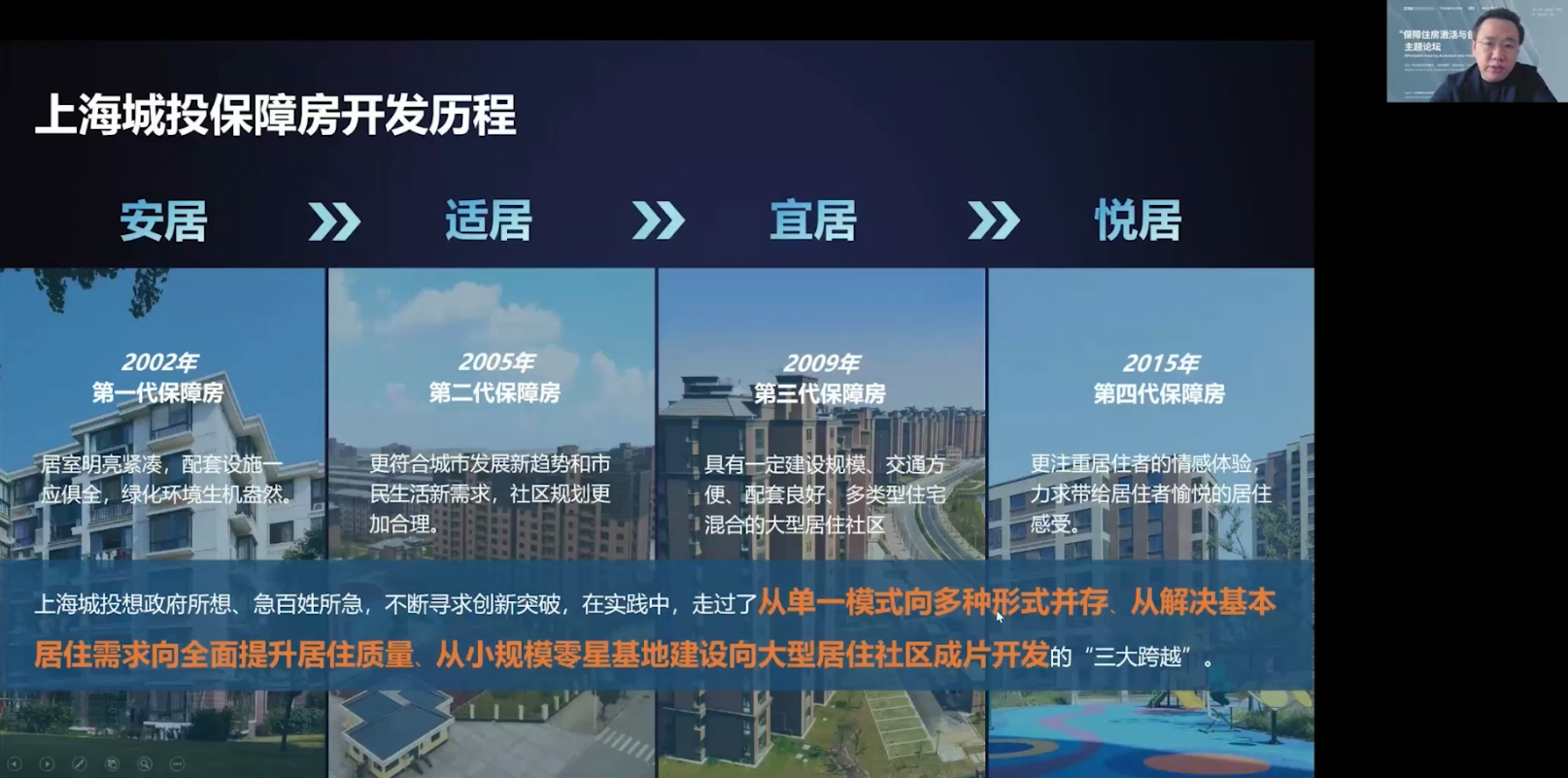
After that, Zhang Chen introduced the current situation and problems of the rental market, and pointed out that for a megacity like Shanghai, affordable rental housing is a necessary and effective supplement to the healthy housing system. At the same time, it is necessary to activate the market under the guidance of policy conditions to ensure healthy supply and create a virtuous circle of supply and demand.
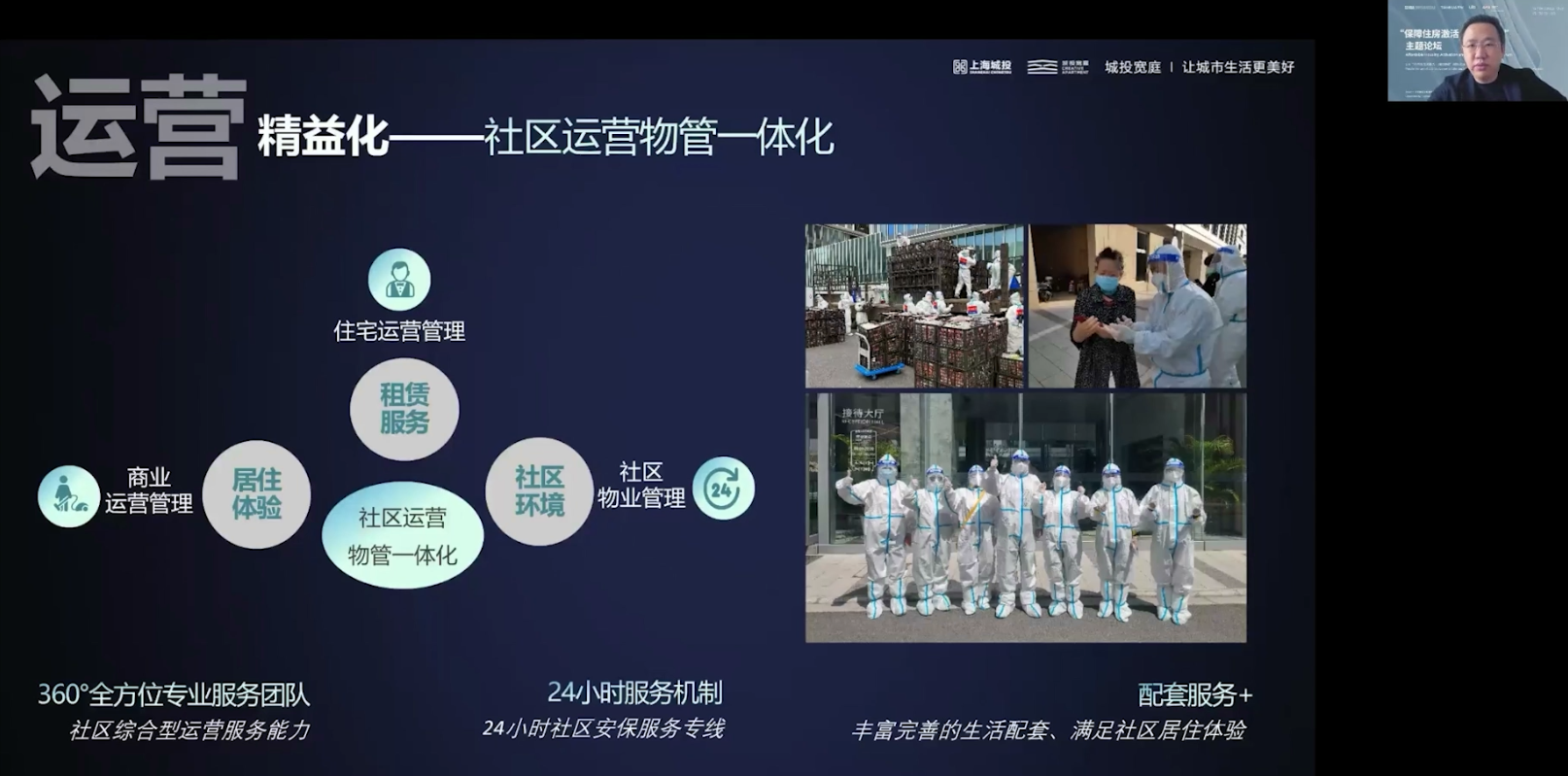
Zhang Chen shared the thinking and practice of Shanghai Chengtou in affordable housing community and rental community, and explained in detail the experience and consideration of planning, development, construction and operation management of Chengtou Kuanting. At the same time, in combination with the problems existing in community management in the recent epidemic control in Shanghai, he introduced the successful experience of Shanghai Chengtou's rental housing operation team in service assurance in Wangu Community, the first project that has been put into operation. Finally, he proposed that residents should have more common sense of belonging through community operation, and young people can change their habits and stimulate new awareness in the rental community.
Round Table Discussion (I)
Housing equity is the embodiment of social equity, and the best efficiency in the housing field is to ensure that the policies implemented by the government and its beneficiaries get the best social effect.
In the first round of round table discussion, the guests discussed the following issues:
How can the goal of "ensuring housing" be translated into quantifiable indicators?
What is the guiding significance of quantitative indicators for the planning, design and construction of affordable housing?
The society is prone to have a negative impression of "low-income groups" for "affordable housing users". Would the affordable housing and ordinary commercial housing become convergent or differentiated?
And how to consider the operational requirements of affordable rental housing in the design stage?
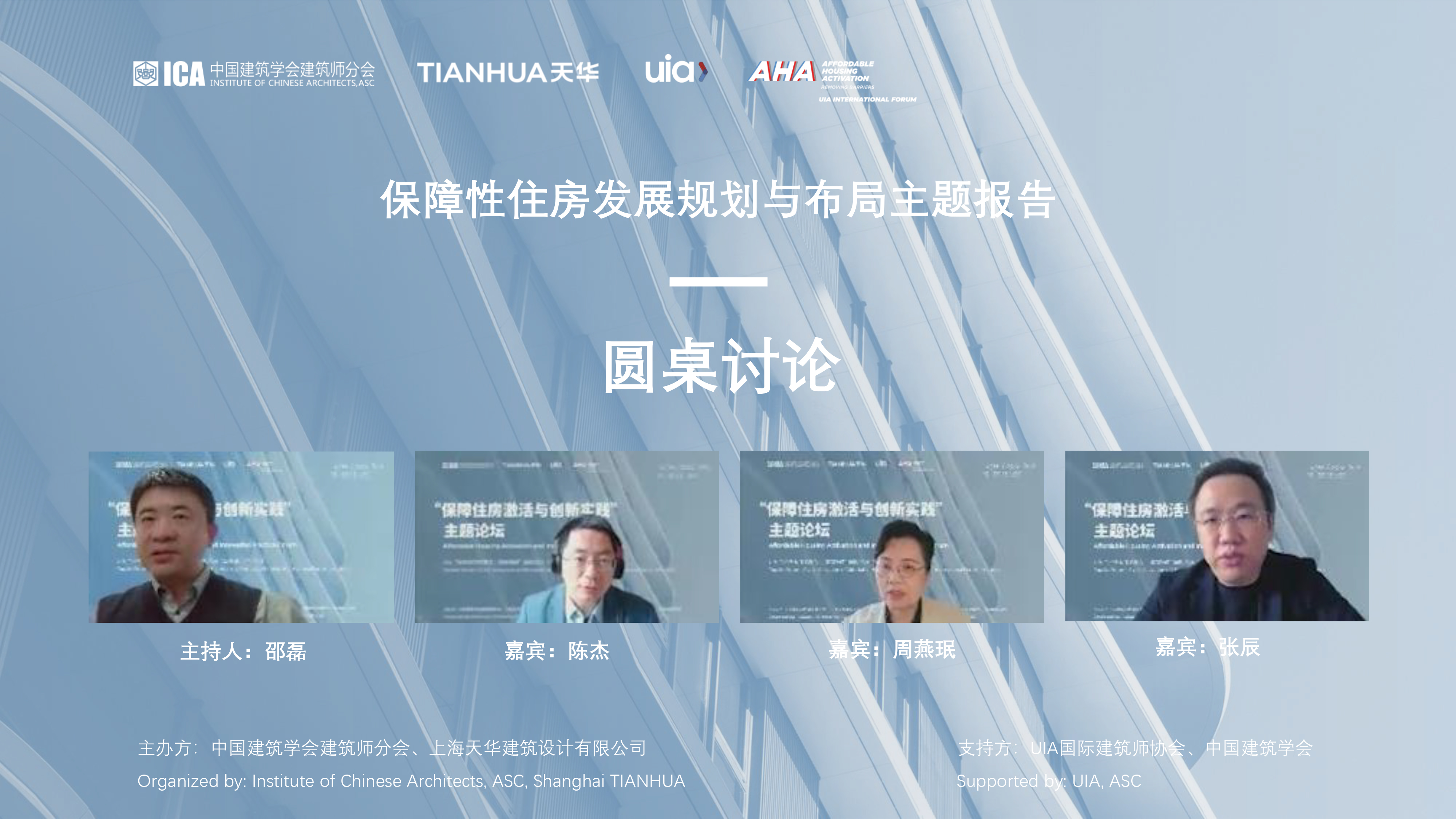
Chen Jie said that "ensuring housing" should first be quantified in terms of area; for residents, we should improve their ability to pay for adequate housing, prevent low income from forming a poverty cluster and causing some social problems, and ensure that housing should be mixed in living form. The image level should not be too different from ordinary commercial housing, but should be distinguished by controlling user type and rents.
Zhou Yanmin said that the design standard of affordable housing should be set up separately, and the general residential code should not be followed; on the design level, the width and depth should be properly adjusted when the housing area is very small; water pipe wells shall be arranged in a centralized manner; the increase of electrical equipment should be considered. In the design, more attention shall be paid to refined and humanized things, so as to design more sustainable buildings.
According to Zhang Chen, the affordable rental housing is a brand new field, with its operating model still under exploration. In the first place, R4 land is a long-period project with heavy assets. Under the guidance of policy, the asset securitization method can be applied to revitalize the initial investment through financial instruments such as REITs, so as to continuously strengthen the project operation level and effectively expand the scale. Secondly, the behavior pattern of renting and buying differs. As thus, the architects shall, in the product design, consider how to meet the basic living needs of residents in such communities from the perspective of human behavior. Moreover, the logic of service apartments and hotels can be applied to operate leasing communities, with an aim to render residents a better living experience.
Keynote Speech (II): Affordable Housing Development Practice and Innovation
The forum entered a speech session with the theme of "Affordable Housing Development Practice and Innovation", chaired by Huang Xiangming, and four design experts well-known in both the industry and the academic circle delivered speeches respectively.
Ma Yansong, the founding partner of MAD Architects, shared a report entitled The Sociality of Social Housing. Firstof all, this report, according to Ma Yansong, is intended to discuss theexpected impact of the community and the city on public rental housing andsocial security housing through the lens of the Baiziwan public rental housingproject. This project is the first social housing project of MAD Architects,which hopes to break through the routine in concrete practice, promote theinnovation of social housing in China with design, adapt the space andarchitecture to serve people, and blend the huge community into the city andits residents, thus awakening the sociality ofhousing and solving a series of specific issues on housing in the rapiddevelopment of Chinese cities currently.
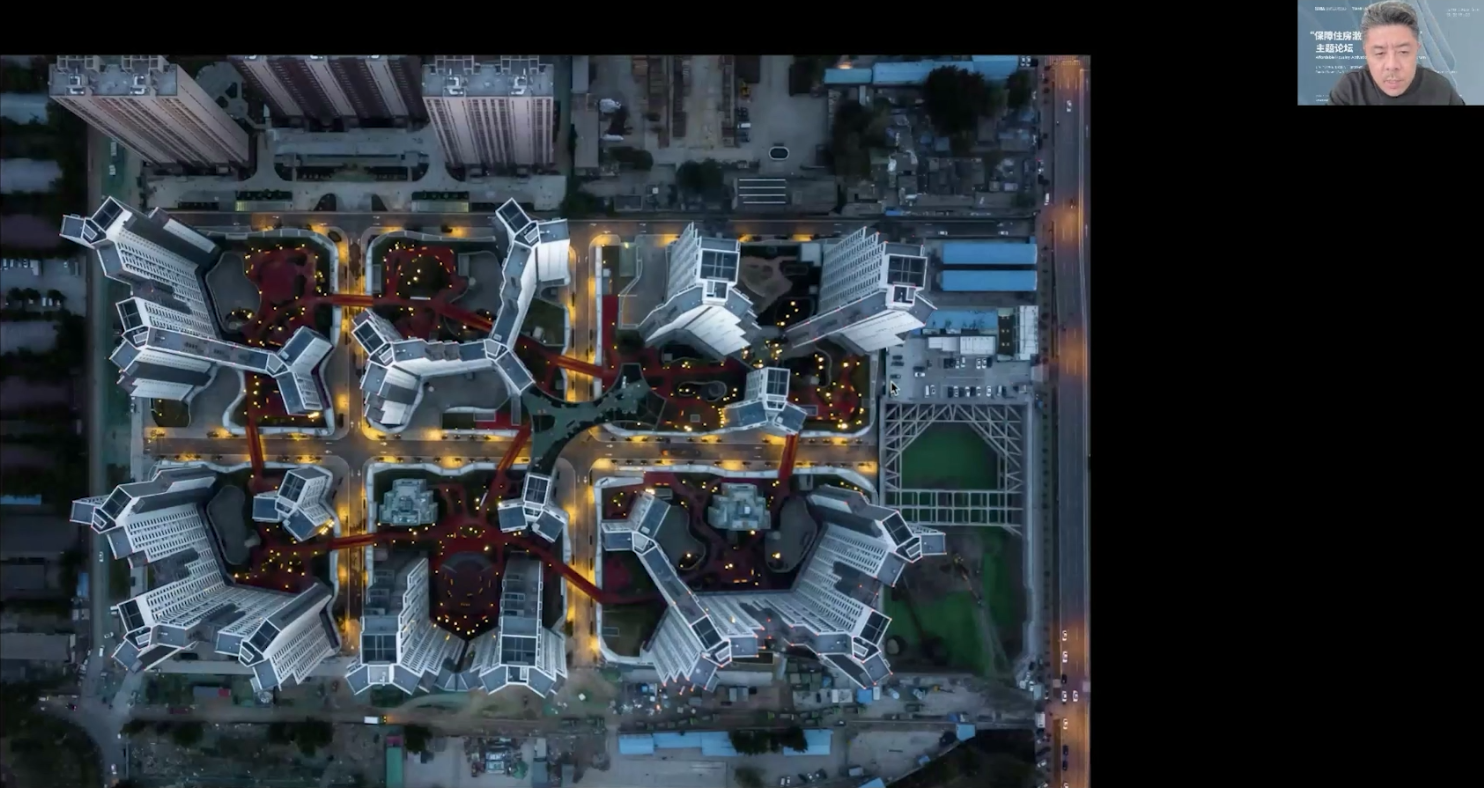
The design opens up the community walls and introduces the urban roads. After returning the functions of the first floor to the city, MAD reserves the second for the internal use of community residents, through which a series of three-dimensional roof greening has been formed. A circular running track encircles the six blocks as an integral whole, transforming it into a giant park. MAD has retained landscapes of varying scales on the first floor, various staggered floors, semi-open gray space and roofs of the building, so that people living here can enjoy a more comfortable life and stay closer to nature. Based on high plot ratio and small size, the project tries to make sunlight available for each room facing different directions. The building plane is Y-shaped, and the set-back design of the top floor shapes the building complex into a "mountain" with scattered heights. The connection between the buildings forms a group of semi-enclosed space, and the pleasant scale endows the space with a sense of intimacy and belonging.
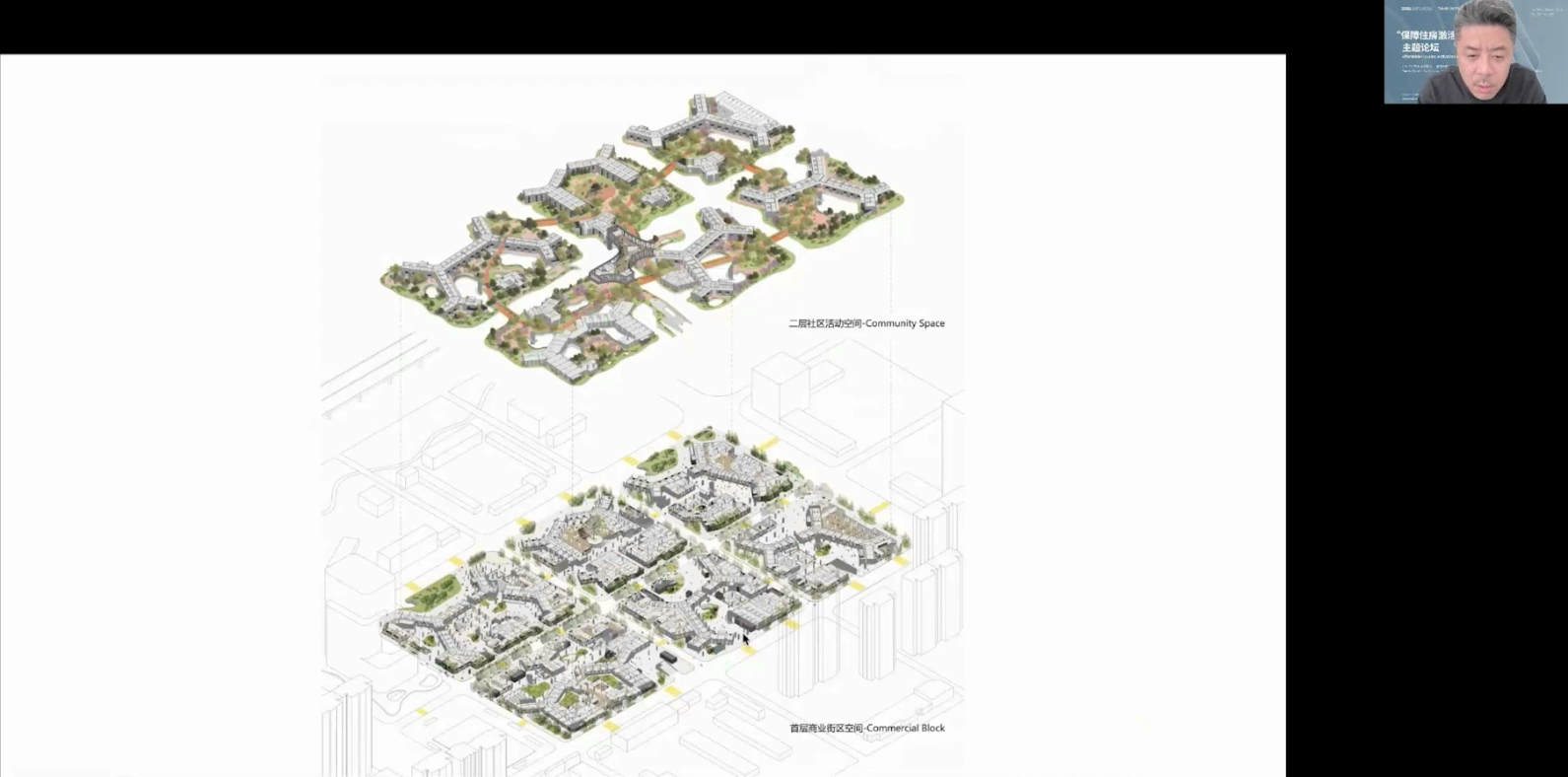
Additionally, the Baiziwan public rental housing adopts light-weight painted panels for the partition wall indoors, making it convenient for maintenance and subsequent decoration and renovation. The project has achieved more than 80% of the industrial construction. Besides, the building structural units and interior decoration all adopt the prefabricated system, which is both efficient and environmentally friendly. In the community are two exemplary buildings featuring ultra-low energy consumption (also known as "passivhaus").
Ma Yansong concluded that the Baiziwan public rental housing put forward the concept of integrating affordable housing communities into urban life, in which streets are introduced through three-dimensional communities, green space and public facilities are maximized, and simple aesthetics and humanized community space are considered as the core of the housing spirit, hence also a brand new exploration towards an ideal residence.
Wang Weiqiang, professor and doctoral supervisor in the College of Architecture and Urban Planning of Tongji University, gave a speech titled Old Community Renovation and Housing Security Construction. According to him, a large stock of housing, mature communities and existing communities in China should be counted as an important factor in the construction of affordable housing. The old community not only holds symbolism and collective memory, but also carries with itself a unique urban morphological value. Besides, as an existing community, it also functions in housing security and elderly support against the backdrop of aging. In view of the above, the research team led by Wang Weiqiang put forward four aspects based on the consideration for continuity of urban development: First, in terms of organization mechanism, the original "government-led and top-down" mechanism should be transformed into a "government-guided and widely-involved" one; regarding fundraising, the "government fiscal appropriation" should be converted to "multi-subject financing" to form a PPP mechanism; concerning systems and regulations, the "strict enforcement of regulations" should turn to "encouragement of reform and innovation"; finally, in planning methods, the "goal-oriented planning" should change into "problem-oriented planning".
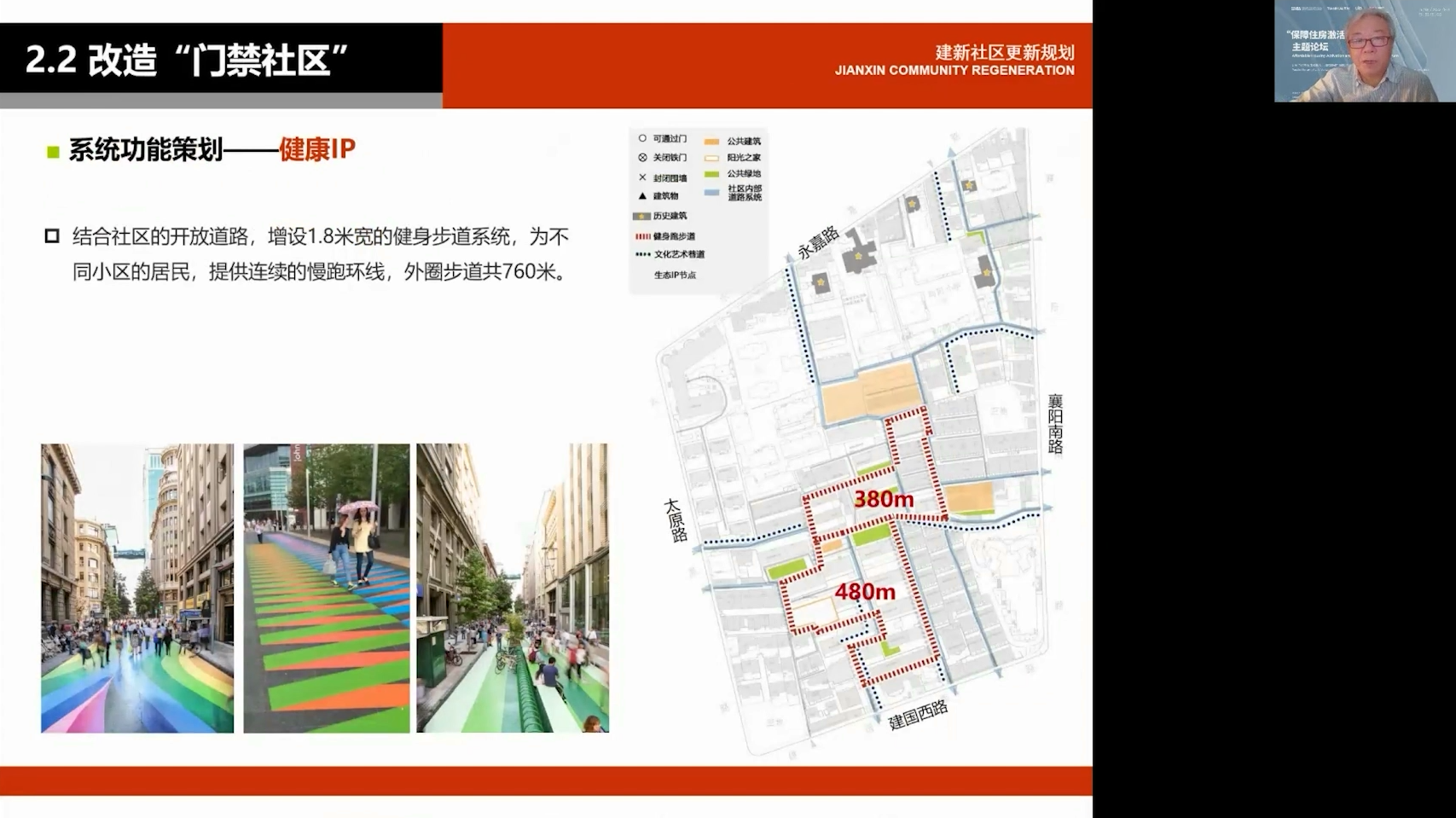
Wang Weiqiang shared his team's research projects, and further explored, from a practical perspective, the significance of the renovation of old communities for urban renewal and affordable housing, as well as the policy bottlenecks therein. The Jianxin community in Tianping Sub-district where the project is located was built long time ago, characterized by complex internal building types and obvious community diversity. The most important subject of the research, in his opinion, lies in how to discover catalysts in urban renewal and enhance community quality from the core. Through a large number of surveys and investigations, three renovation nodes were selected to improve the overall cohesion and exchange rate of the community, supported by the increase of capacity, public service as well as public space.
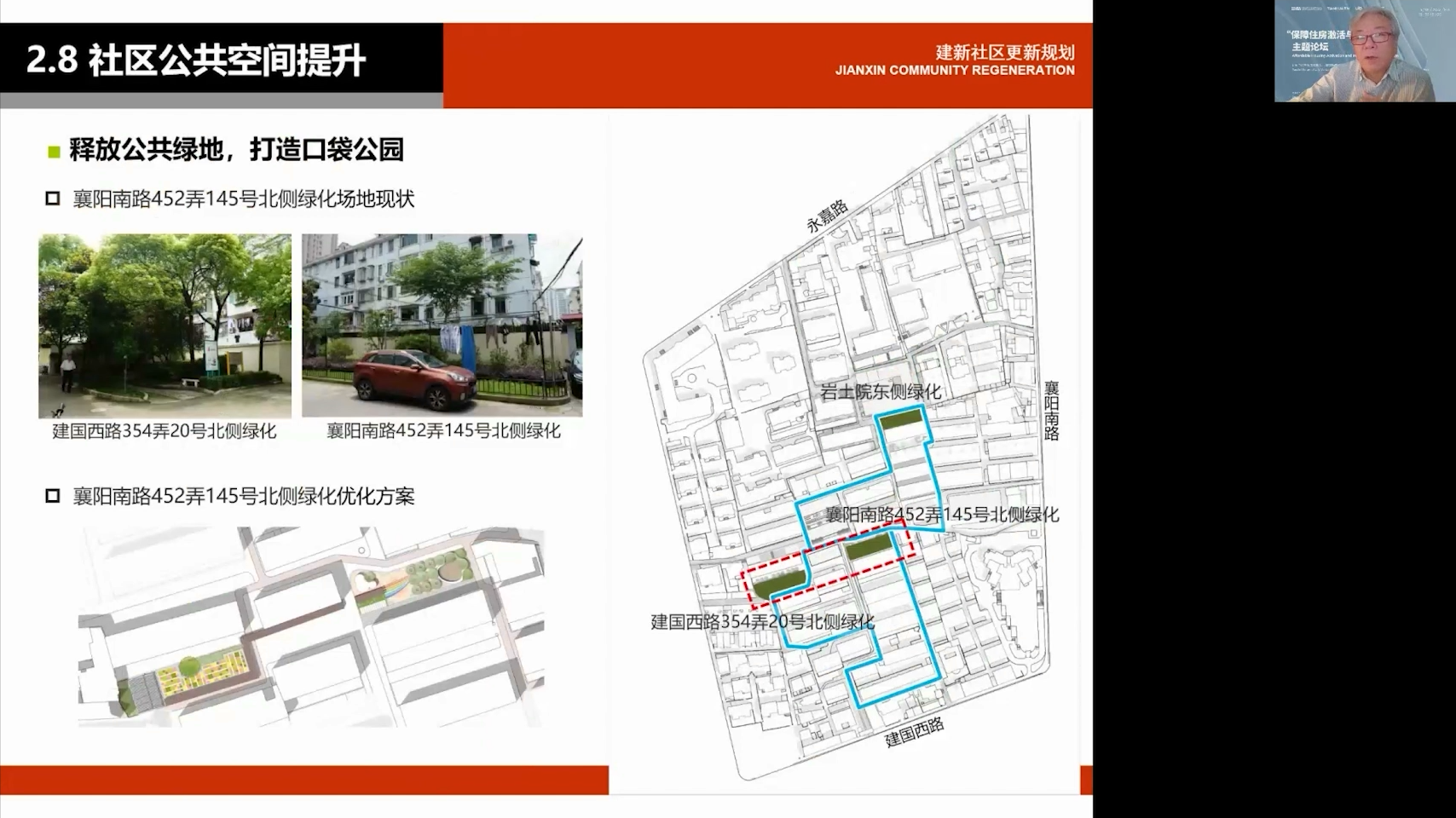
Finally, he brought forward some thoughts: Firstly, in terms of housing reform policy, can we achieve the continuation of the after-sale public housing policy and let the people enjoy the dividends from reform and opening up? Secondly, how can the development of commercial housing be carried out under the condition that the stipulated land must be auctioned and listed? How can social capital be mobilized for transformation of such a scattered plot, and his return be guaranteed? Finally, concerning capacity control and regulatory control, can a new policy method be figured out to adopt the renovation of existing communities, rather than the implementation of the renovation method applied in newly-built areas?
Zhang Jiajing, the presiding architect of Shanghai Atelier GOM Construction Design Consulting Co., Ltd., an expert of the Shanghai Planning Commission and a visiting professor of the School of Design, Shanghai Jiao Tong University, gave a keynote speech titled All with One Voice. First of all, he briefly described the meaning indicated in the title of the report and introduced in detail the research cases and specific practices of GOM on the evolution of affordable housing in Shanghai over the years.
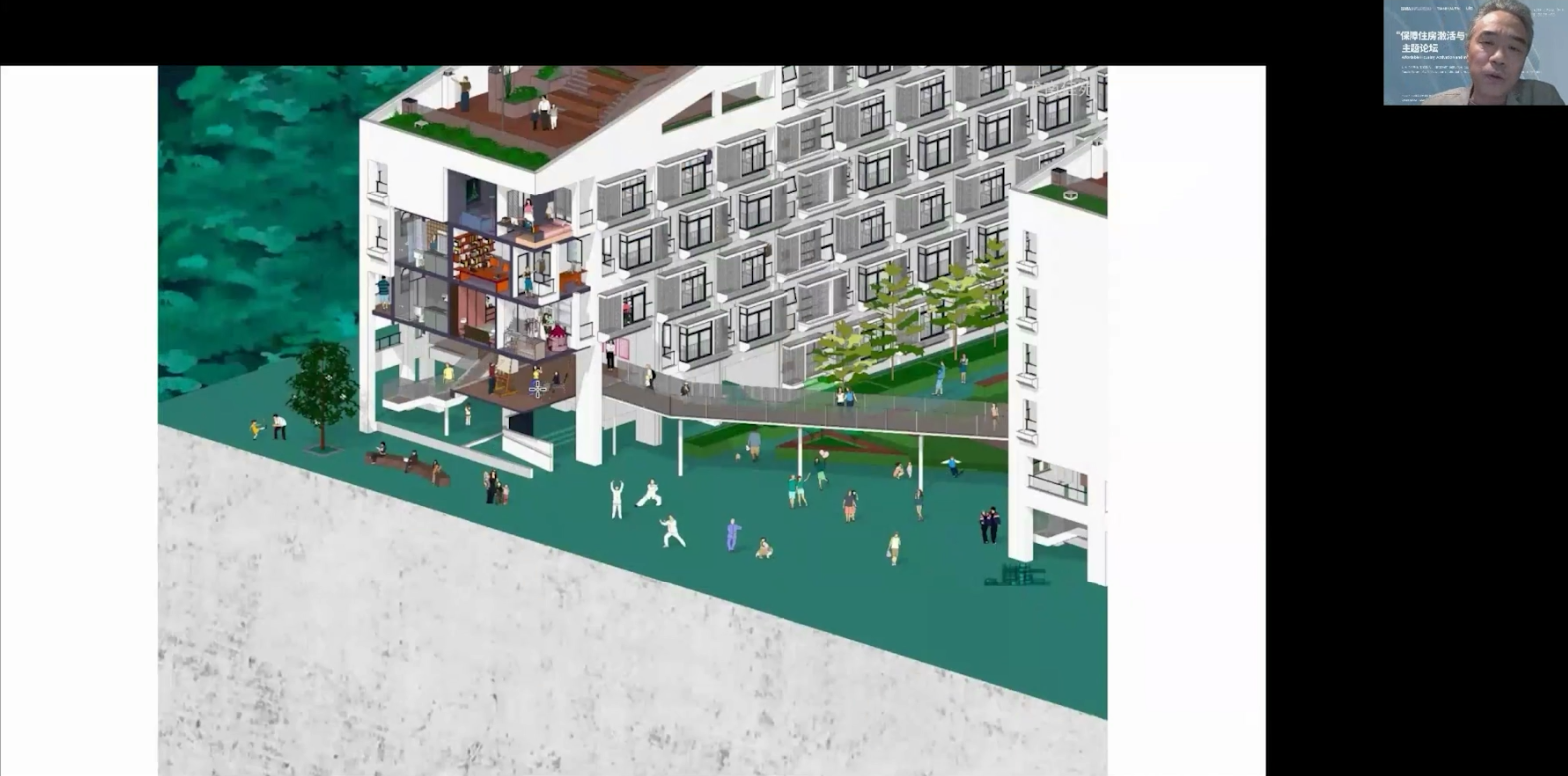
According to him, the GOM team completed, in the first stage of research attempts, the design and research of several virtual projects through virtual modeling, specification interpretation, volume research, etc., the results of which have laid a good theoretical research foundation for later practice. The Longnan Jiayuan project is a design that integrates the research results of GOM over the years and is completed at one stretch. However, a lot of controversy has also been aroused at the same time, owing to the fact that the project is relatively new and accompanied by a series of problems such as the lack of preliminary planning and construction quality. In addition, when the project was submitted for construction, they found that although Shanghai took the lead in releasing housing regulations, the lack of proper policy interpretations in the public rental housing guidelines for some innovative design still remained then. After numerous appeals, coupled with the joint efforts of the designer and the specification maker, the project finally landed. However, it is undeniable that the completion of Longnan Jiayuan, in a sense, had the Shanghai affordable housing norms confirmed, which also played a certain guiding role in the formulation of other Shanghai norms.
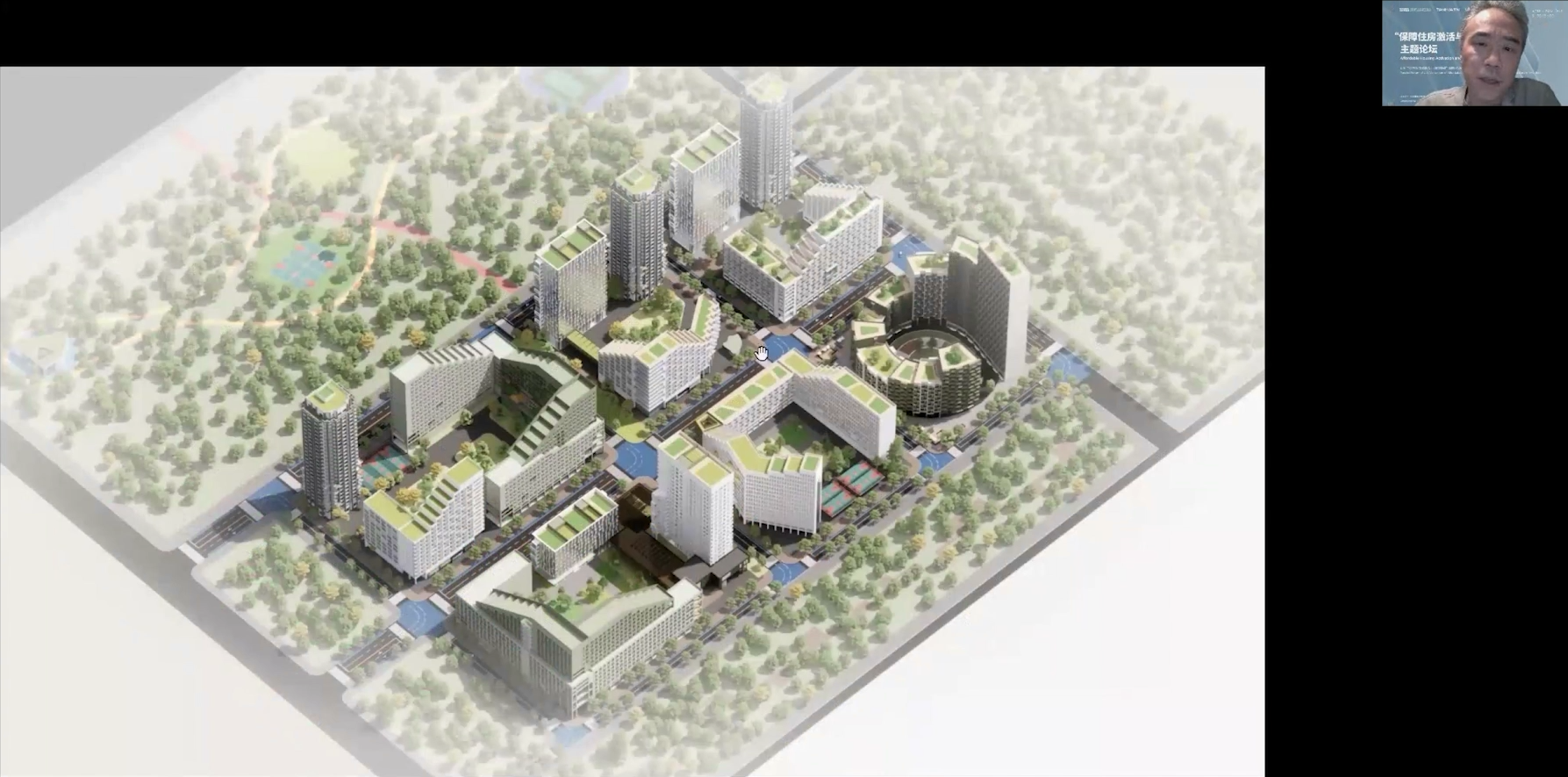
The second part shared by Zhang Jiajing was inspired by netizen discussions on the Baiziwan public rental housing, in which Ma Yansong took the lead for design. They hoped that Zhang Jiajing would comment on the project from the designer's point of view. He chose to redesign the same plot guided by his own ideas, and tried a "tower house", through which a different design was completed finally with all design requirements of the project satisfied. From a professional point of view, he discussed with Ma Yansong upon different design ideas. In addition, Mr. Zhang Jiajing also briefly introduced two public rental housing projects under construction. The design of these two projects has drawn lessons from various previous experience, optimized the research and positioning of target customers and launched a product system that is more in line with modern life.
In the end, he concluded that "all with one voice" represented the design and opinions of different designers in the industry. Even if their design styles differ, they all rely on their own abilities to improve the discourse power and design standards of Chinese architects in social housing design, endeavoring to contribute their own strength to the development of affordable housing in China.
Wu Xin, the vice chief architect of TIANHUA Group and a doctor of architecture, presented the theme report titled Creativity and Technology Integration: Design Innovation of Prefabricated Rental Housing. The report mainly discussed the topic of construction, centering on the first-prize project of the 2020 "Real Estate Residential Development" Shanghai Prefabricated Building Design Competition that TIANHUA participated in.
The project base is located in the World Expo section in Pudong, Shanghai. The Competition is intended to promote the establishment of a prefabricated design concept with architecture as the leader, and to integrate the idea of prefabricated buildings throughout the design process, so as to make prefabricated building products more reasonable, green and energy-saving. Designers from different majors in TIANHUA architecture, structure, electromechanics, interior space, operation and maintenance jointly participated in the research and design of the project.
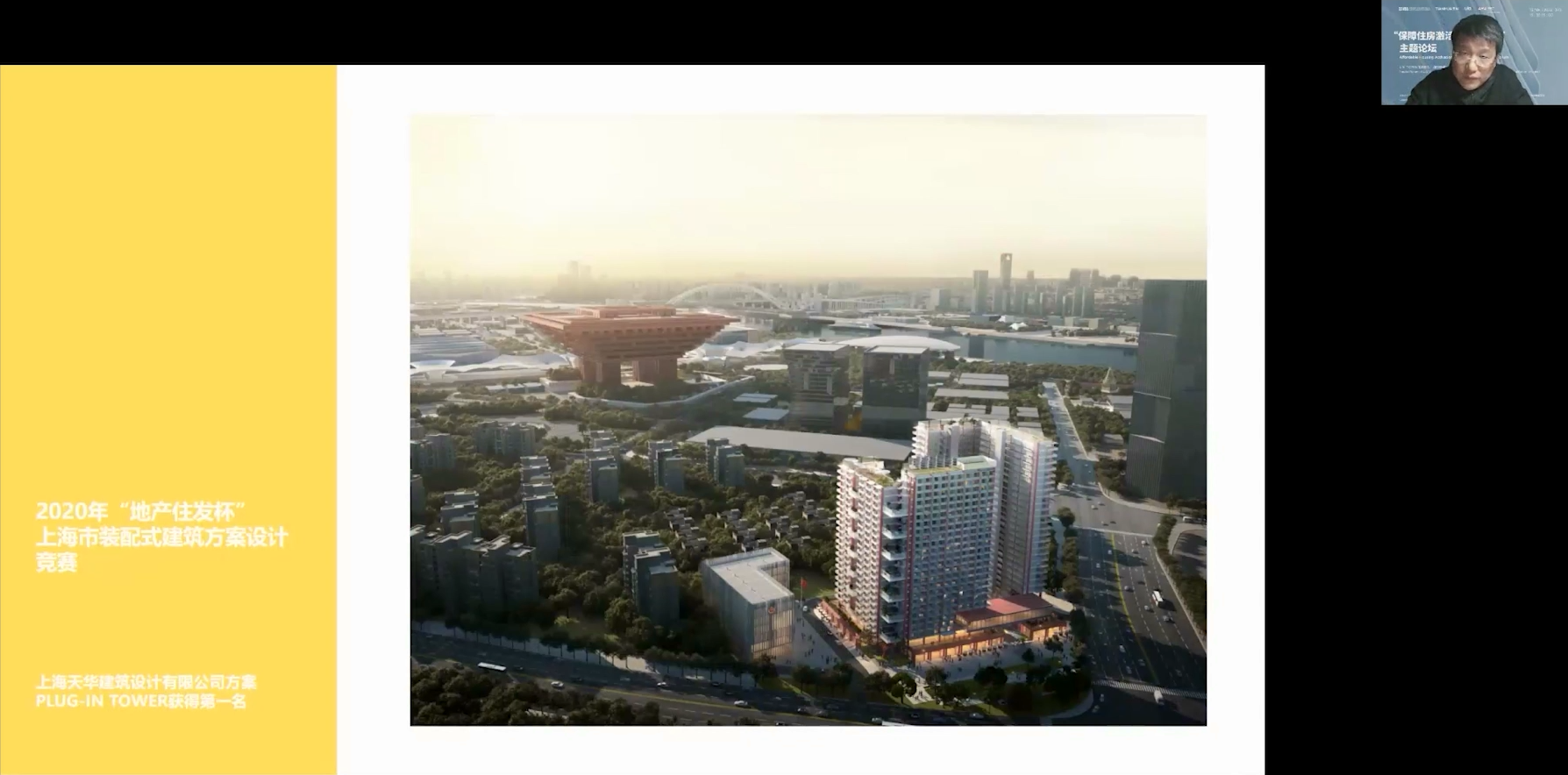
The preliminary design concept of the project, pointed out by Wu Xin, took industrial design as the starting point, and explored applicable logic that can be used for reference in designing prefabricated rental housing, mainly through analogy studies of the industrial design usage, practicability, safety, ergonomics and human-computer interaction, universality and differentiation, as well as self-evident formal design.
Back to the most basic design vision, some requirements starting from the space users need to be addressed. The first lies in the future-oriented spatial variability, which TIANHUA achieves by utilizing furniture in the basic unit modules. To meet the demand for natural lighting and ventilation to the greatest extent, the single corridor form was adopted to generate a reasonable architectural form on the site. In terms of space vitality, more green open space per capita and safer and more convenient public facilities were applied to create a composite multi-type space. Finally, the building was placed in the urban dimension to deal with the openness of the community and the urban interface, and connect people, nature and the city at relevant space joints.
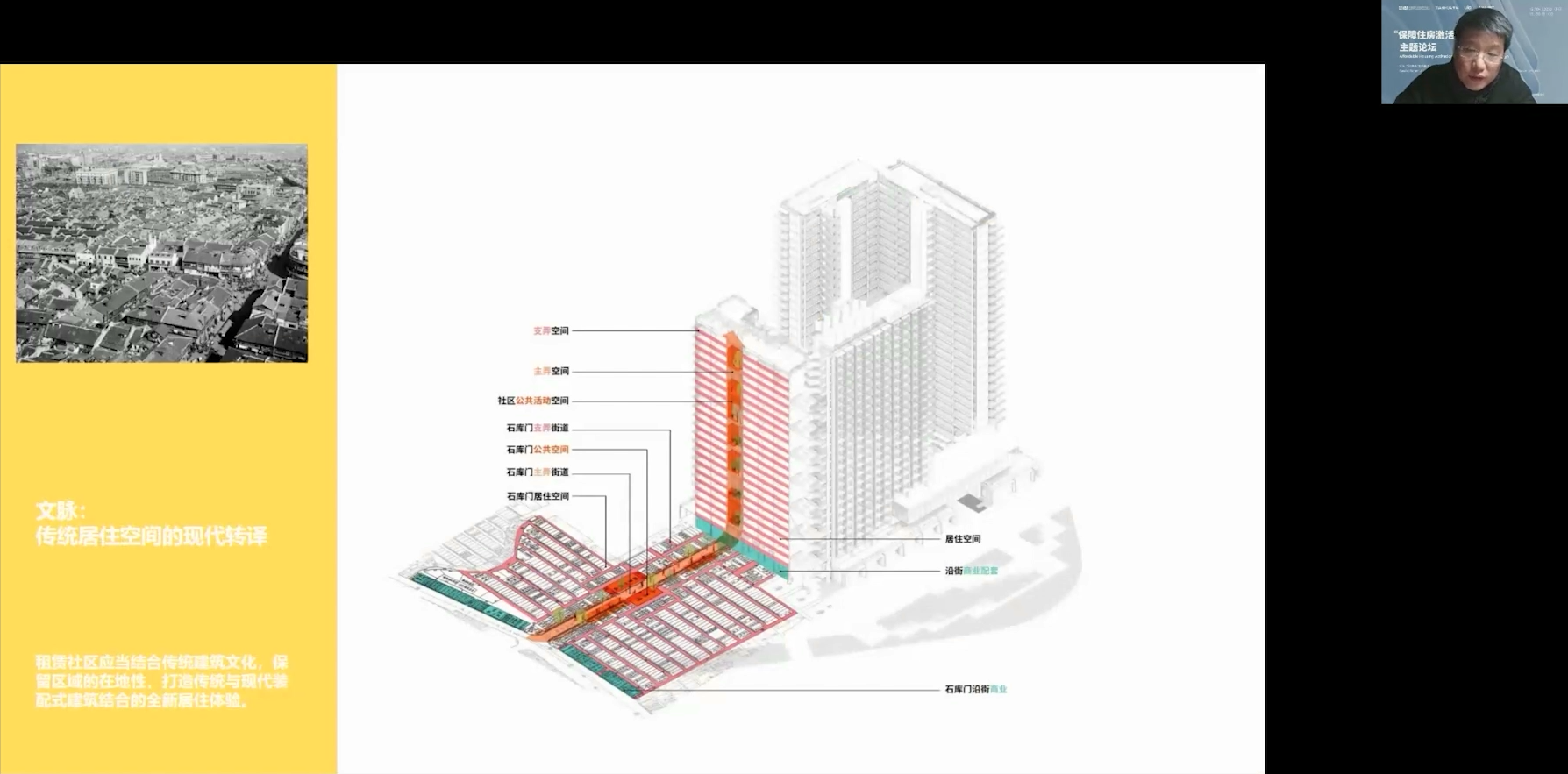
Focusing on the topic of "reasonable construction", Wu Xin expounded his understanding on prefabricated rental housing from the perspectives of structural reasonability, clarity of components, convenience of packaging and maintenance, production and transportation cost, brand recognition and family sense. In addition, referring to modular electronic products, TIANHUA has designed the architecture of modular buildings: the main frame provides structure, power, water supply and drainage, residential units and other modules were connected with the main body through interfaces for different functions and switching. The modular interior decoration was realized through standardized processing of dry technique. The design of large-proportion standard members, prefabricated parts with high repetition rate and high-proportion standardized edge members at the structural level has become the innovation of the fabricated system.
In the end, Wu Xin concluded that this design, starting from the way of industrial design and focusing on the discussion and research on "design", "logic" and "reasonable construction", was a meaningful attempt.
Round Table Discussion (II)
Affordable housing shall not be a lowland in residential design, but a field full of possibilities and potentials that is worth exploring. In the second round of round table discussion, the guests discussed the following issues:
How can architectural design improve the sense of identity and happiness about communities of affordable rental housing users when the cost allows?
What is the focus of affordable housing design in the context of urban renewal?
How to better combine the creativity on space in affordable housing design with standardized construction?
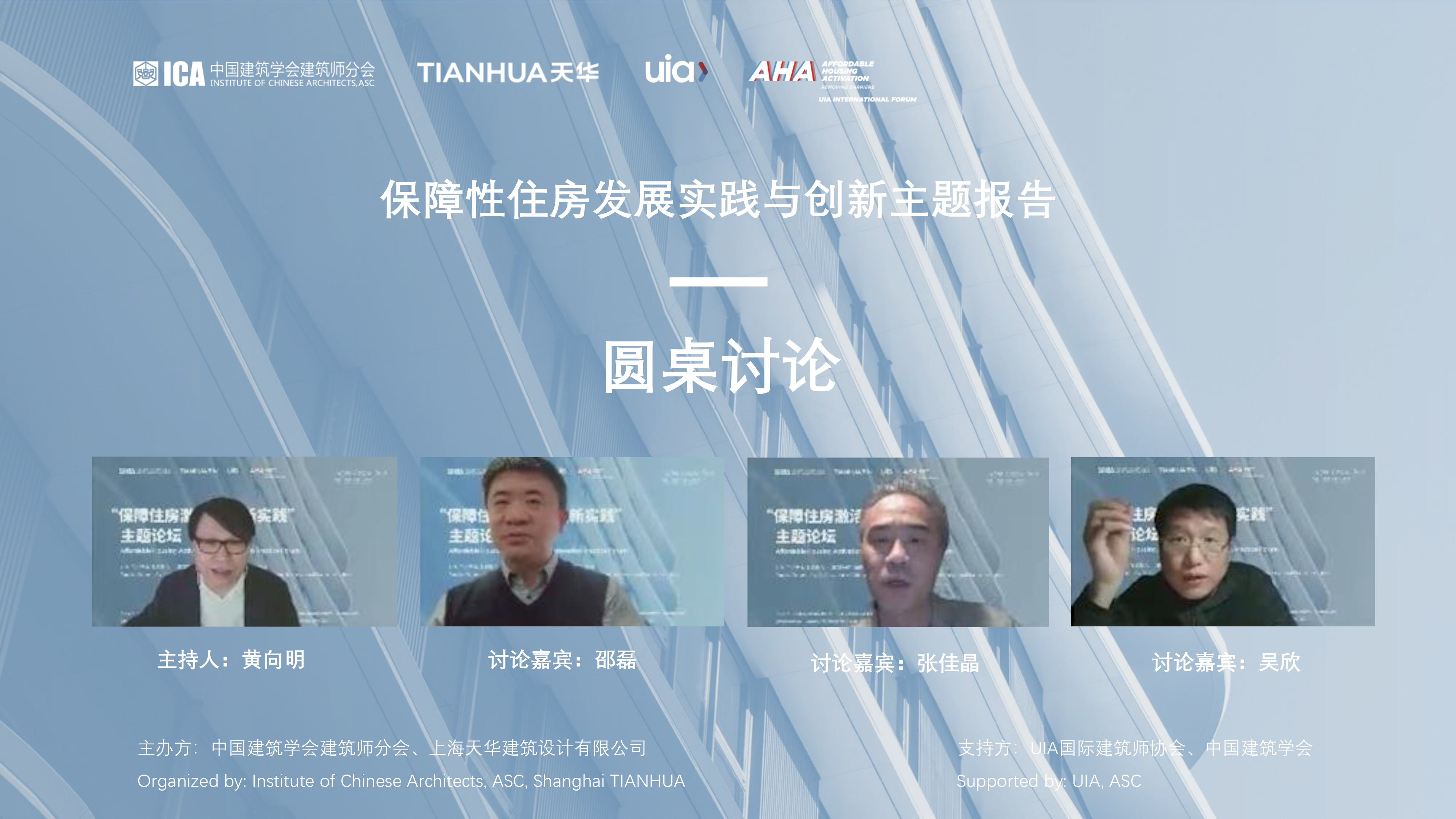
Shao Lei said that firstly, the preconditions and constraints of the project affected the design to a great extent. Design was to seek logic and innovation under specific conditions and backgrounds. Secondly, the discussion on the sense of identity and happiness about affordable housing was actually to explore what life aesthetics looked like from the perspective of residents. Housing could be regarded as consumption from the perspective of leasing, which required architects to understand the pain points and needs of it from the level of residential consumption, including personal income, housing policy, urban inclusiveness and other influencing factors. Architects shall not start from the design level alone, but shall broaden their horizons and seek a more comprehensive and complete design cognition.
Zhang Jiajing said that based on the experience gained from practical projects in recent years, which referred to the significance of "community" to young people, the "look" and trend of buildings were more attractive to young people. When designing, attention shall be paid to the public space providing that the private indoor space was designed well enough. Meanwhile, he pointed out that good property management would be a plus to the community. In addition, unreasonable building codes might stifle many innovative designs. He proposed that local urban guidelines for affordable housing could be formulated according to the actual situation, referring to experience and data of architects after practice appropriately.
Wu Xin expressed his views on affordable housing communities from the perspective of neighbors. He believed that in such communities, the residents were more aggregated. There was stronger public character in such communities, with the corresponding sense of identity and happiness about community different from ordinary communities. Therefore, he pointed out the importance of building rental housing communities. Community operation was not just simple property management, but more importantly, to integrate different groups into a harmonious community. Wu Xin believed that the neighborhood atmosphere reflecting humanism and civil life was very important, which shall be taken into consideration by architects when designing to reserve more possibilities at the level of space construction.
Closing Session
At the end of the forum, Dr. Joseph Kwan MH, director of Area IV of the AFA Work Programme of the UIA and winner of the medal of honor in the Hong Kong Special Administrative Region, made a closing speech.

He mentioned that the forum was a support and echo for the UIA "Activation of Affordable Housing (AHA): Removing Barriers" International Forum held in Madrid from May 18 to 20, 2022. The forum focused on the two themes of affordable housing, namely "planning and layout for the development of affordable housing in China" and "practice and innovation for the development of affordable housing in China". The seven keynote speeches in the forum covered the prospect of housing security, interpretation of housing policy, national and industrial standards and regulations of housing design in China, development and operation, design practice and community participation, innovative housing design and current social housing transformation in the context of urban renewal, which were all related topics to solve the demand for affordable housing economically, feasibly and sustainably. In this regard, he sincerely expressed his gratitude to the Institute of Chinese Architects, ASC and Shanghai TIANHUA Architecture Planning & Engineering Ltd. for forum organization, the UIA for the support, and the seven keynote speakers for their wonderful speeches. He also hoped that this forum would be an international event of multiple significance.
